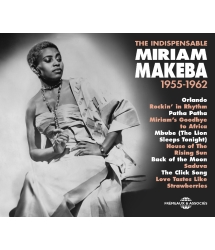South African singer Miriam Makesa should need no introduction, one of the first artists to introduce African Music to the West in the 1960s and a tireless critic of the apartheid regime in South Africa, but I confess I have never really listened to her music in any great depth. This set comprises three discs, respectively titled “Apartheid In Joahnnesburg”, “Africa’s Queen Of Soul”, and “New York”. The first CD contains plenty of American-influenced material, opening with three titles recorded by Miriam with The Manhattan Brothers and very much in the style of The Mills Brothers and The Ink Spots. It then moves on to recordings credited to female group The Skylarks, formed in imitation of the American close harmony group The Boswell Sisters. Miriam’s voice is unmistakable. This material is often jazz-inflected and/or traditional and accompanied by a small rhythm section, though the a cappella “Hush” is sung in English and is better known maybe as “When Death comes Creeping In Your Room”- there is also a male bass singer on this, as there is on another spiritual, “Live Humble” and several others. Prophetically, ‘Kutheni Sithandwa” is a successfully localised adaptation of Harry Belabonte’s then current hit, “Day-O”. Some of these performances are best described as “beautiful”, and the group’s output, with Miriam taking the lead continues onto the second disc. This opens with 1959’s cover of Duke Ellington’s “Rockin’ In Rhythm”, a scat vocal atop a swinging rhythm section and a penny whistle solo; this “kwela” influence continues on the following two numbers, and also turns up on a couple of later titles. “Make Us One” is musically close to the American gospel sound of the time, and the tracks from the formal show tunes “Back Of The Moon” and “Quickly In Love” (from the musical “King Kong”) onwards are credited to Miriam alone. 1959’s “Phata Phata” is tangentially linked to her big hit “Pata Pata” of two years earlier. This section ends, naturally enough, with the gospel-flavoured ballad “Miriam’s Goodbye To Africa”. The remaining titles – the last four of two and all of the third CD-were all recorded in New York, with Miriam being embraced by the folk revival and rising to a position similar to that of Harry Belafonte, who had taken up her cause and who virtually became her manager. The results are variable, though the a cappella “Umhome” and the remake of “Olilili”are still powerful performances. Her version of “Mbube” is presumably the original inspiration for the Tokens’ “The Lion Sleeps Tonight3 (U.K. readers might also recall Karl Denver and “Wimoweh”), the mento “The Naughty Little Flea” comes from the Belafonte connection, and so does “Can’t Cross Over”, designated on this release as an “Indian Calypso”, which certainly had me intrigued until I realised that the word “West” is missing from the beginning. “House Of The Rising Sun”is fairly typical of the more sophisticated end of the folk revival spectrum at the time (think Odetta, Leon bib or latter-day Josh White, whilst “One More Dance (Darling Go Home)” is not a track I’d care to listen to again! After this though, several of the tracks have a more “African” sound (and her fellow countryman and future husband, trumpeter Hugh Masekela is present on some of the remaining titles), although a Brazilian song, a curious (I’m being diplomatic) “Inca Ballad”, an overly dramatic number in “Night Must Fall” and the aforementioned “Can’t Cross Over” are also included, to emphasise her international approach and appeal.
In short a fine if variable introduction to this artist. Musically, the earlier South Africa recorded sides are far more successful as some of the crossover attempts of the “made in America” numbers are noticeably dated, or perhaps were less than successful in the first place. The notes are extremely informative, but if you’ve read Miriam’s autobiography “Makeba: My Story”, there is little that is new. That’s just an observation, not a criticism.
Par Norman DARWEN – BLUES & RHYTHM
In short a fine if variable introduction to this artist. Musically, the earlier South Africa recorded sides are far more successful as some of the crossover attempts of the “made in America” numbers are noticeably dated, or perhaps were less than successful in the first place. The notes are extremely informative, but if you’ve read Miriam’s autobiography “Makeba: My Story”, there is little that is new. That’s just an observation, not a criticism.
Par Norman DARWEN – BLUES & RHYTHM











